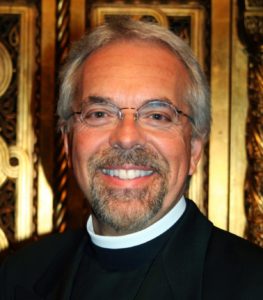
Fr Frank Marangos
Source: Oinos Educational Consulting
By Frank Marangos, D.Min., Ed.D., FCEP
One of the earliest depictions of the handshake is found on an early 5th Century BC marble column currently on exhibition in the Acropolis Museum in Athens Greece. The archaeological relief depicts Hera, the wife of Zeus and the goddess of marriage, shaking hands with Athena, the goddess of wisdom in ancient Greek Mythology. Symbolizing the Decree of Samos (405 BC) enacted at the end of the Peloponnesian War, the handshake between the mythological patron deities of Athens and Samos commemorates their respective city’s military accord. The salutation of Athena and Hera, however, expresses much more than political solidarity. Their embrace may also be understood as signifying the invaluable alliance of wisdom, strength, and marriage.
Handshaking, as a ubiquitous global greeting, has been recently declining due to fear of spreading the COVID-19 Virus through physical contact. Suggested alternatives include the elbow bump, foot-shake, and bow. Some have even suggested the use of the Star Trek Vulcan salute. Whatever option is finally accepted, however, one would assume that the handclasp between a bride and groom will continue to be enacted in most wedding ceremonies. In fact, asking for a daughter’s “hand in marriage” will certainly remain a custom in many religious communities. In the Orthodox Christian Church, the celebrant joins a couple’s right hands to validate their pledge to serve, provide hospitality, and, above all, to “pass on” their faith tradition (I Cor. 11:2) to their children.
Like the Orthodox Christian Church, the Catholic Church emphasizes the importance of the household handshake. “Through the grace of the sacrament of marriage,” insists the Catechism, “parents receive the responsibility and privilege of evangelizing their children.” As the “first heralds” for their children, parents are encouraged to “initiate their children at an early age into the mysteries of the faith.” A “wholesome family” argues the Catechism, “should associate children from their tenderest years with the life of the Church . . . a life that can foster interior dispositions that are a genuine preparation for a living faith and support throughout one’s life. In turn,” insist the text, “children will contribute to the growth in holiness of their parents.”
In many ways, like Athena and Hera, the household handclasp is a sacred commitment of marriage’s filial solidarity with spiritual wisdom. While the social handshake may soon become obsolete, the gesture will most assuredly continue as a vivid liturgical symbol of the spiritual legacy transfer between generations. A positive, yet unintended consequence of social distancing might, therefore, be the opportunity for occasions of healthy family proximity to emerge. While the Coronavirus has reminded the nation that human connection can spread illness, the pandemic has simultaneously provided the environment wherein families can re-discover the value of sharing quality time together. Consequently, although pews are empty, and business offices, malls, and golf courses are temporarily silent, neighborhoods are bustling with the sound of multi-age family activities. In many ways, social distancing may have actually provided the environment for parents to renew the physical, emotional, and spiritual components of their marital handshake.
Unfortunately, many households today have unhinged their handshake role of “passing on faith.” Numerous studies chronicle the devastating effects of this religious neglect and the corresponding phenomenon of single-parent homes. According to the United States Office of Statistics, there are approximately 95 million single-family homes in the U.S. as of 2019. However, while children who grow up with only one of their biological parents (nearly always the mother) are disadvantaged across a broad array of outcomes, the lack of households focused on “passing on faith” to their children has also produced troubling spiritual consequences.
In their noteworthy study, The Demographic Characteristics of the Linguistic and Religious Groups in Switzerland (2000) Werner Haug and Phillipe Warner reveals several sobering conclusions concerning the generational transmission of faith and religious values and the importance of the father in religious parenting. “It is the religious practice of the father of the family,” insist the researchers, “that determines the future attendance at or absence from church of the children.” The study provides five significant conclusions:
- If both father and mother attend regularly, 33% of their children will end up as regular churchgoers, and 41% will end up attending irregularly. Only a quarter of their children will end up not practicing at all.
- If the father is irregular and mother regular, only 3% of the children will subsequently become regular churchgoers themselves, while a further 59% will become irregulars. Thirty-eight percent will be lost.
- If the father is non-practicing and mother regular, only 2% of children will become regular worshippers, and 37% will attend irregularly. Over 60% of their children will be lost completely to the church.
- If the father is regular but the mother irregular or non-practicing, the percentage of children becoming regular churchgoers increases to 38% with the irregular mother and up to 44% with the non-practicing.
- If the father regularly attends church, regardless of the practice of the mother, between two-thirds and three-quarters of their children will become churchgoers (regular and irregular).
In the more recent research report “Who Is Responsible for Children’s Faith Formation?” (2019), the Barna Group concludes that Gen Z (born between 1997 and 2012) is “coming of age in a post-truth world that no longer shares the same moral principles and societal values of their parents.” The research also indicates that parents (especially engaged Christian parents) are “eager for their children to develop a lasting faith, yet lack clarity on how to discipline their children well in a decidedly post-Christian context.”
Like Haug and Warner, Barna concludes that church leaders “are in agreement” that the responsibility for a child’s spiritual formation and development should “start with parents” (99% of Protestant pastors; 96% of Catholic priests), followed by the “Church itself” (92% of Protestant; 77% of Catholic). Despite the fact that church leaders overwhelmingly agree that parents are most responsible for a child’s spiritual formation and development, the data unfortunately demonstrates that religious institutions “place little emphasis on training and equipping” parents. More troubling, the Barna study points to a “possible disconnect among church, home, and school relationships,” as well as the need for “new conversations and partnerships for addressing spiritual formation in the current context.”
Holy Scripture is replete with lesson-laden hand and hand-clasping narratives. Old Testament personalities such as Abraham, Joseph, Moses, David and many prophets all used their hands to convey blessings, collaboration, consecration, treaties, friendship, and even marriage. Apart from imparting cures, the New Testament chronicles a noteworthy episode wherein Jesus used His own hands to bless children. “Do not hinder them from coming to Me,” He cautioned, “for the kingdom of heaven belongs to such as these” (Matthew 19:13-14). Framed in such a fashion, the marriage ceremony’s handclasp may be understood as a couple’s public concession of Jesus’ exhortation. By joining hands, husbands and wives are, therefore, accepting the household responsibility of “passing on” (paradosis) a God-centered relational faith to their children.
One of the most helpful instructional anthologies for households interested in passing on the wisdom of living a moral life pleasing to God is the Book of Proverbs. Four basic principles of the household handshake may be outlined from a review of the first chapter of this insightful Old Testament text: (1) instruction, (2) discernment, (3) guidance, and (4) integrity. Accord to King Solomon, the presumed author of Proverbs, the goal of instruction is to perceive “wisdom, justice, judgment, and equity” (Proverbs 1:2-3). Used over 25 times in the Book, the Hebrew word for instruction, however, also emphasizes the importance of discipline. As such, instruction for Solomon, is the foundational step to positive behavior including self-respect, deference to others, good health, sound relationships, and the blessing of God throughout life. Undisciplined behavior, on the other hand, is explained as the reason why some generations are robbed of joy, peace, strength, and prosperity.
While secular society emphasizes financial and vocational success, the scripture-based household handshake commends the strength, wisdom, and integrity of simultaneously developing an authentic relationship with God. Couples who understand their parental responsibilities in these terms will endeavor to teach their children the importance of developing the capacity of discernment. By advancing the exhortation of Jesus concerning the two most essential commandments of the Mosaic Law, namely, love of God and love of neighbor (Matthew 22:37-40), parents can help their children learn how to discern the proper manner of forming solid relationships with God and with others.
The third foundational principle of the household handshake entails the guidance provided by both parents. Accordingly, if the “beginning of knowledge” is the “fear of the Lord” (Proverbs 1:7-8), then fathers and mothers must spend adequate time mentoring their children with authentic examples of servanthood, humility, and selflessness. Only in this fashion can the default modes of power, arrogance, and self-promotion communicated by the mediums of modernity be counterbalanced.
Philosophers like Pythagoras and Plato generally taught that, as the family is the keystone of society, parents should be “honored next to the gods.” In like fashion, Solomon insinuates that the nurture of parents should not be despised but understood by their children as “fine jewelry.” A “father’s instruction,” and a “mother’s teaching,” he insists, “are a graceful garland for a child’s head and pendant for their neck” (Proverbs 1:8-9). Consequently, the impact of a household faithfully advancing Proverb-based instruction, discernment, and parental influence on their children will lead to the fourth foundational principle of the household handshake, namely, the development of integrity (honesty and uprightness).
Developing the spiritual aptitudes of children through the “passing on” of faith is a long-term undertaking that requires parents to take their familial household handclasp seriously. The 4th Century Christian Archbishop, Saint John Chrysostom, often suggested how parents could transfer such faith-inspired capacities to their offspring. Apart from selecting their names from inspirational saints, Chrysostom emphasized the value of teaching children the importance of prayer and studying the Bible. Scriptural wisdom, he insisted, “is a priority” for a blessed life. “Let everything take second place to teaching them to love true wisdom,” he insisted. By teaching children to worship, read the bible and sing hymns, “they will have great wealth and glory than riches can provide.”
The result of advancing the aforementioned foundational distinctives cannot be overstated. According to the Catechism of the Catholic Church, “the role of parents to educate their children is primordial and inalienable . . . this education is of such importance that it is almost impossible to provide an adequate substitute.” “Parents,” the Catechism continues, “bear witness to this responsibility by first creating a home where tenderness, forgiveness, respect, fidelity, and disinterested service are the rule.” Like Chrysostom, the text exhorts that the “home is best suited for education in the virtues. This requires an apprenticeship in self-denial, sound judgment, and self-mastery.” While the father’s role is a significant factor, however, the Catechism stresses that the collaboration of both parents is the most comprehensive method for transferring the world-view of faith to children. But what can be done to assure such mutuality? How can the marriage ceremony’s handclasp pledge be more fully advanced?
Passing on the Faith: Transforming Traditions for the Next Generation of Jews, Christians, and Muslims (2006) by James Heft, President and Founding Director of the Institute for Advanced Catholic Studies stresses the importance of transmitting religious identity from one generation to the next. Using essays from scholars and religious leaders across three faiths and many disciplines, Heft examines how families and religious institutions deal with the challenge of faith transfer. The author concludes that the process of religious diffusion in and by the family has never been more challenged than today.
In their book, Families and Faith: How Religion Is Passed Down Across Generations (2014), Vern Bengtson, Susan Harris and Norella Putney conducted the largest study of religion and family across generations. Winners of the Distinguished Book Award from the American Sociology Association of Religion, Bengtson and his colleagues studied more than 350 families to ascertain how religion is, or is not, passed down from one generation to the next. The researchers established that despite enormous changes in American society, a child is actually “more likely to follow their parents’ example than to rebel.” While the authors agree with Heft that “outside forces do play a negative role,” the study concluded that the crucial factors in whether a child keeps the faith is “the presence of a strong parental bond, ” and especially that “of the father.”
According to author Dave Keehn, “each generation has memories, stories and spiritual values of faith that it wants to pass along to the next generation . . . not to be dropped after they leave the home.” Passing on faith “begins in the family home as spiritual practices,” he insists, adding that knowledge is also transferred “through the larger community of faith.” In his book, Passing on Our Faith – One Generation to Another (2014), however, Keehn outlines 3 myths about passing on faith to the next generation. The myths include the unfortunate assumptions that faith: (1) happens by osmosis, (2) is the responsibility of professionals, and (3) not worth the effort.
According to Keehn, some parents believe their children will “catch their spiritual values” by simply being around them and the Church. While it is true that values are more often casually “caught” than formally taught, intentionality is the only way that underlying significance can be adequately understood. On the other hand, other parents entirely abdicate their teaching responsibility, arguing that lack of knowledge or their prior mistakes disqualify them from being the primary spiritual influence in their child’s life. Tragically, Keehn describes a final group of parents who believe that any attempt to “pass on the faith” is not worth the effort, arguing that adolescence is a season of independence and rebellion. The prophet Samuel chronicles the impact of parents who failed to instruct their children to honor God on the larger community. “After that whole generation had been gathered to their fathers,” he laments, “another generation grew up who knew neither the Lord nor what he had done for Israel” (Judg. 2:10).
Finally, echoing the research conclusions of Bengtson, Harris, and Keehn, Peter Kahn argues that the most valuable legacy parents can pass on to our children, grandchildren, and other children is the “presence of a lived spiritual heritage.” Like the previous authors, Kahn emphasizes the responsibility that is entrusted to religious couples, namely “the passing on the living faith to their children.” In Passing on Faith to Your Children (2018), Kahn examines how parents can work together with their respective faith-communities to meet their formation responsibilities. The book explores the “kind of faith” that households should strive to pass on to their children, and gives practical help on how to provide a positive, rich and complete environment for such spiritual development to occur.
A story is told of a family who owned an antique Greek vase. The exquisite objet d’art was passed down from generation to generation. One day, the parents left their teenagers at home while they went out shopping for the day. When they returned home, their children met them at the door with sad faces. “Mother, Father,” they lamented, “you know that priceless heirloom our family cherishes . . . well, our generation just dropped it.”
The partial societal shutdown caused by the Coronavirus pandemic provides an opportunity for each household to assess the condition of their respective priceless porcelains of faith. Scripture is clear, the consequence of sin is separation from God. It is a primordial estrangement – a spiritual distancing – that is further exasperated when couples unclasp their hands. Parents should, therefore, not assume that their children will receive the religious legacy of the faith-tradition through osmosis and/or merely as a result of summer youth camps and irregular catechetical attendance. Nor that they will value and protect such a priceless inheritance. On the contrary, as the passing on of faith must continue to be refreshed with each generation, couples might consider using their current émigré of social distancing as a most valuable opportunity to evaluate the resolve of their respective familial handclasp.
Passing on a life-sustaining legacy of faith is far more important than the temporal inheritance of cherished pottery and financial portfolios. Unfortunately, casual miss-handlings of faith have the tendency of forming flaws, cracks, and breaks. By following the foundational principles of instruction, discernment, guidance, and love can parents leave the most valuable of fragile vases to their children, namely, the ceramic of a spiritual inheritance. As Solomon insists, “a good man/woman leaves an inheritance for their children’s children” (Proverbs 13:22).



